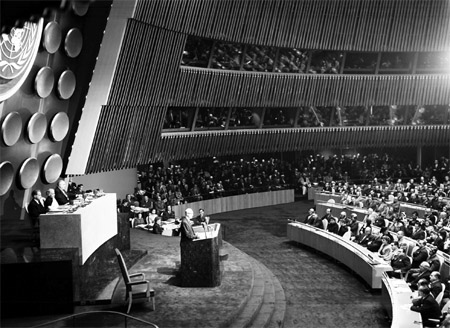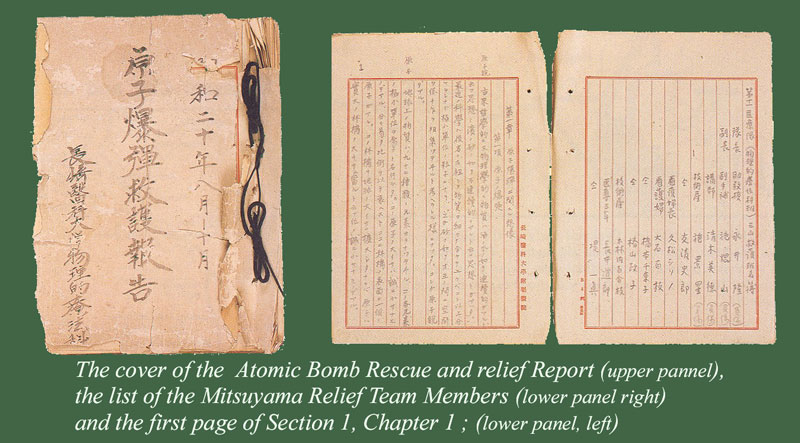1953: Eisenhower’s initiative for peaceful use of the atom
After the Second World War, The United States and the Soviet Union found themselves engaged in a nuclear arms race, and thus in a cold war that would last half a century. It was on December 6th 1953 – at the heart of this Cold War – that American President Eisenhower proposed the adaptation of nuclear technology for peaceful ends. The courageous ‘Atoms for Peace’ initiative is the forefather of today’s attempts to develop safe nuclear energy.

Eisenhower and atoms for peace
On the 6th of December 1953, after a conference in Bermuda with Winston Churchill and Joseph Laniel (the forgotten French Prime Minister of the time), the American President Dwight Eisenhower spoke to a UN general assembly about the peaceful uses of the atom. Eisenhower’s ‘Atoms for Peace’ initiative, proposed at the heart of the Cold War, is at the origin of the peaceful uses of nuclear technology.
© DR/United Nations
The war had transformed the Supreme Commander of the Allied Forces into a pacifist. The 11 months of campaigning which had followed the D-day landings on June 6th 1944 had profoundly affected him, and resulted in a change of heart on a number of key issues. He had seen at first-hand how war can destroy cities, kill innocent civilians as well as military personnel, ruin economies and tear apart the foundations of civilisation. The spectre of what he saw in Europe would haunt him for the rest of his life. As President, he maintained the United States military budget at a minimum, and eloquently expressed his convictions at the inaugural address.
Excerpt from President Dwight D. Eisenhower speech announcing the « Atoms for Peace » program.
Despite its significance at the time, the ‘Atoms for Peace’ initiative is all but forgotten in today’s Europe. Its fifty-year anniversary was celebrated in New Orleans in November 2003, during a biennial conference which brings together key players in nuclear industry. The theme of the opening session was to ask whether the atom could bring us prosperity in times of peace.

Dr. Nagai report’s cover
Dr. Takashi Nagai’s words came at the end of a summary, written on a simple notebook, of the rescue operations entitled: ‘Atomic bomb, rescue and relief report’. This report, written for the President of the Nagasaki Medical University (who died before receiving it), was thought lost for 25 years. On the left we can see the title page and on the right facsimiles of the first page and a list of members of the Mutsyiama rescue team, led by Dr. Nagai.
© NASHIM (Nagasaki Association for Hibakushas Medical Care)
During this conference, Professor Yoichi Fujiyii-e, the President of the influential Japanese Atomic Energy Commission, gave an informal talk to the young engineers and industry workers who were in attendance, joining them on the floor of the assembly. Combining the past with the future, he ended with a quotation that is all the more remarkable given it was first made in 1945:
A testimony from Nagasaki’s victims …
« Everything was finished. Our mother land was defeated. Our university had collapsed and classrooms were reduced to ashes. We, one by one, were wounded and fell. The houses we lived in were burned down, the clothes we wore were blown up, and our families were either dead or injured. What are we going to say? We only whish to repeat this tragedy with the human race. »
« We should use the principle of the atomic atom. Go forward in the research of atomic energy contributing to the progress of civilization. A misfortune will be then transformed to a good fortune. The world civilization will change with the utilization of atomic energy. If a new and fortunate world can be made, the souls of so many victims will rest in peace. »
These sobering lines were written at the time of the bombing of Nagasaki by Dr. Takashi Nagai, a radiologist at Nagasaki University who was among the first to take part in the rescue operations. His words prefigured the reaction of the entire Japanese people. In the aftermath of one of the largest civilian massacres in history, one might have expected to hear words of despair, hatred and revenge. By contrast, these lines indicate a tremendous spirit of recovery, of peace, and of hope.
Transforming catastrophes into blessings, and constantly moving forward are characteristically Japanese traits. Indeed, no other country made a similar investment to the ‘Atoms for Peace’ programme. Over the past sixty years, however, the world has changed. The nuclear threat has been diminished but still remains. Eliminating this threat, fighting poverty, coping with climate change and ensuring sustainable development are all problems which a peaceful use of atomic technology can help to solve.
Other articles on the subject « Military Applications »
Nuclear Weapons
Atomic and thermonuclear bombs There are two types of nuclear bombs: the atomic A bombs and the t[...]
The 1945 A-bombs
Little Boy and Fatman The United States had available three bombs in July 1945: two made of pluto[...]
The Franck Report
The Scientists who opposed dropping atomic bombs on Japan In June 1945, shortly before the atomic[...]
Nagasaki
A Japanese account of the Nagasaki bomb Atomic bomb, rescue and relief report, a poignant small b[...]
Nagasaki First Aid
Extracts from Doctor Takashi Nagai first report In this first rescue report intended for the auth[...]
Testing Nuclear Weapons
A practice that culminates in the 1950’s and 1960’s… The nuclear tests conducted by the sup[...]
Atomic Tests Fallout
An embarrassing legacy but alleviated with time Radioactive fallout differ significantly accordin[...]
Arsenals reduction
A modest step towards a reduction in nuclear arsenals During the Cold War, the United States and [...]